Saba is the sister island of St. Maarten, a short 45-minute ferry ride or 10-minute flight away. It is one of the smallest inhabited islands in the Caribbean, a mere five square miles. Its land surface consists mostly of the inactive (for now) volcano called Mount Scenery. At 877 meters, this is the highest point within the entire Netherlands ‘kingdom’ or any of its territories. Saba, including the tiny offshore islet of Green Island, became a special territorial municipality after the dissolution of the Netherlands Antilles in 2010.
News alert December 19, 2012:
Legalization of gay marriage sends Saba’s popularity soaring
Little Saba, an autonomous Dutch territory has approved gay marriage as of December 1, 2012 making it the first such island in the Caribbean to officially legalize same-sex unions. Read more.
Gay Life?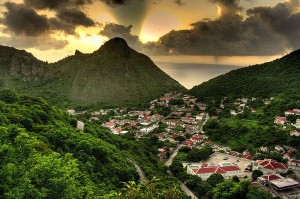
“Saba is not a hot bed of gay activity. There’s not a single gay bar, but LGBT visitors have taken note of the island’s welcoming spirit and underwater treasures. The island’s hospitality providers estimate that about 80 percent of visitors come to Saba to don a wetsuit and peer at sea life — including gay and lesbian scuba groups organized through gay tour operators such as Alyson Adventures and Undersea Expeditions.” (OutTraveler 2009)
The island is a ‘live and let live’ sort of place which invites gay friendly attitudes to develop along with with gay owned businesses, resorts, hotels and villas for rent. “‘Saba is everything that circuit parties are not,” says Paul Cizek, owner of Tropics Café, one of the island’s favorite eateries, with his partner Chris Fries. “It’s for gay travelers who are not looking for a party atmosphere.” The couple, former Washington, D.C.-area real estate agents, moved to Saba in 2008 after vacationing there for years. Both men are effusive  about the island. But they’re also very careful to describe Saba as a low-key destination for gay tourists. ”It’s a conservative place,” Fries says, “in the sense that it’s a peaceful piece of paradise with its own values.” (OutTraveler 2009)
about the island. But they’re also very careful to describe Saba as a low-key destination for gay tourists. ”It’s a conservative place,” Fries says, “in the sense that it’s a peaceful piece of paradise with its own values.” (OutTraveler 2009)
Another gushing admirer has claimed, “it is vying for the gayest island in all of Caribbean. Its slogan: The Unspoiled Queen. Here there are comfortable LGBT residents plus an openly gay commissioner, a director of tourism, and member of the island council, who are all pushing to have same-sex marriage legalized, which given that Saba is under jurisdiction of the Netherlands, should be any day now.”
Because of the hilly terrain there are many magnificent eco-vistas to admire across the dense foliage to the blue-green seas beyond. Saba is a tranquil place where a visitor goes to unwind.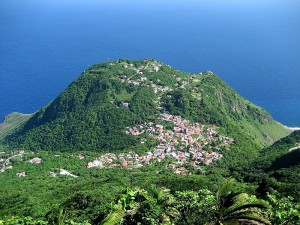 There are no long sandy (or nude) beaches and no trendy nightclubs. But, there are rural laid back cocktail hours, folksy neighborhoods and tasty eating establishments that are ‘typically Caribbean’.
There are no long sandy (or nude) beaches and no trendy nightclubs. But, there are rural laid back cocktail hours, folksy neighborhoods and tasty eating establishments that are ‘typically Caribbean’.
OutTraveler (gay travel magazine) has written, “overall, there’s not much to do here other than dive or hike and get away from the crowds, but that’s the point: rest and romance. Check into Queen’s Gardens Resort, a comfortably chic yet rustic 12-suite property with splendid sea views, run by a charming Dutch couple with mostly Dutch and American staff. The locals are friendly and relaxed. Hiking the rainforest cliffs is invigorating. Walking the island is not to be missed!! And the Scuba diving!”
Local Talk
Saba’s main town and capital is oddly named The Bottom, the first stop on the way from Saba’s Port in Fort Bay towards the rest of the island. It has approximately 500 inhabitants of the total 1,424 islanders. The Bottom is home to the government offices, a hospital, a nursing home, a sports field, three 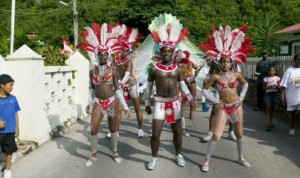 churches, a library, various shops and a university. The Bottom is also home to the Saba Carnival which is held once a year during the summer, as well as Saba Day in December. Dutch is the official language but English is the principal language spoken.
churches, a library, various shops and a university. The Bottom is also home to the Saba Carnival which is held once a year during the summer, as well as Saba Day in December. Dutch is the official language but English is the principal language spoken.
The original name of the town was De Botte, old Dutch for “The Bowl”, referring to its geographical position in a valley surrounded by the various hills. “The Bottom” is an English corruption of this name.
In the 17th and 18th centuries its major industries were sugar and rum, and later fishing, particularly lobster fishing. In the 17th century Saba was believed to be a favorable hideout for Jamaican pirates. England also deported its ‘undesirable’ people to live in the Caribbean colonies who also became pirates. The most notable native Saban pirate was Hiram Beakes, who famously quipped, “Dead men tell no tales.” Legitimate sailing and trade later became important and many of the island’s men took to the seas, during which time S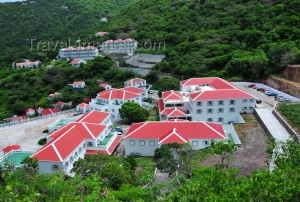 aba lace became an important product made by the island’s women.
aba lace became an important product made by the island’s women.
Saba is home to Saba University School of Medicine (photo right), formerly in Montserrat, which was established by American expatriates in coordination with the government of the Netherlands. The school adds over 300 residents when classes are in session, and it is the prime educational attraction. The A.M. Edwards Medical Center is the major provider of healthcare for local residents. A real queen, Beatrix of Netherlands and her family, visited in 2011.
The island is relatively new to the tourism industry, with about 25,000 visitors each year. The island has a number of inns, hotels, rental cottages and r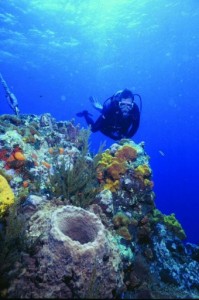 estaurants. The island is especially known for its eco-tourism, having exceptional scuba diving, climbing and hiking. A non-governmental conservation organization, Saba Conservation Foundation, helps protect the nature and culture of the island. See tour video.
estaurants. The island is especially known for its eco-tourism, having exceptional scuba diving, climbing and hiking. A non-governmental conservation organization, Saba Conservation Foundation, helps protect the nature and culture of the island. See tour video.
Saba’s colorful and pristine coral life make it one of the most interesting places to scuba dive in the world, and is often listed as one of the Top 10 diving destinations globally. The waters around Saba were designated as the Saba National Marine Park in 1987. (Source: Wikipedia)
Compiled by Richard Ammon
GlobalGayz.com
September 2012
















